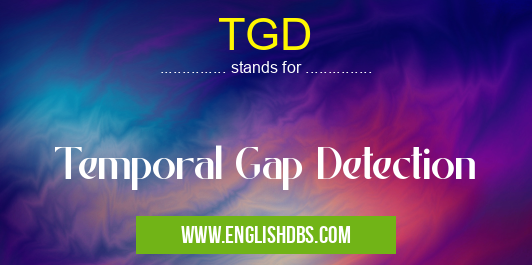What does TGD mean in UNCLASSIFIED
TGD (Temporal Gap Detection) is an essential cognitive function that allows individuals to detect interruptions or gaps in a sequence of events. It plays a crucial role in our ability to perceive and process temporal information, such as the duration of events, the order of occurrences, and the detection of changes in the environment.

TGD meaning in Unclassified in Miscellaneous
TGD mostly used in an acronym Unclassified in Category Miscellaneous that means Temporal Gap Detection
Shorthand: TGD,
Full Form: Temporal Gap Detection
For more information of "Temporal Gap Detection", see the section below.
What is TGD?
TGD refers to the ability to identify and perceive gaps or intervals in a temporal sequence. It involves the detection of a disruption in the continuity of events, allowing us to distinguish between continuous and discontinuous sequences. This cognitive function is essential for various cognitive tasks, including:
- Timing and rhythm: TGD enables us to perceive the duration and spacing of events, such as the beat of music or the intervals between speech segments.
- Memory and recall: It assists in the retrieval of information by detecting gaps in memory sequences.
- Language comprehension: TGD helps in the processing of speech and the detection of pauses or hesitations in conversations.
- Action planning and execution: It supports the coordination of motor actions, allowing us to adjust our movements and respond to changes in the environment.
Essential Questions and Answers on Temporal Gap Detection in "MISCELLANEOUS»UNFILED"
What is Temporal Gap Detection (TGD)?
TGD is the ability to detect a brief interruption or gap in a continuous sequence of stimuli. It is a fundamental perceptual skill that allows us to perceive the world as a continuous flow of events rather than a series of discrete moments.
How is TGD measured?
TGD can be measured using a variety of methods, including the gap detection task and the temporal bisection task. In the gap detection task, participants are presented with two stimuli separated by a brief interval and are asked to indicate whether they perceived a gap between the stimuli. In the temporal bisection task, participants are presented with two stimuli separated by a variable interval and are asked to indicate whether the interval is shorter or longer than a standard interval.
What factors affect TGD?
TGD is affected by a variety of factors, including the duration of the gap, the intensity of the stimuli, the spatial separation between the stimuli, and the context in which the stimuli are presented.
What is the neural basis of TGD?
The neural basis of TGD is not fully understood, but it is thought to involve a network of brain regions, including the primary auditory cortex, the secondary auditory cortex, and the prefrontal cortex.
What are the applications of TGD?
TGD has a variety of applications, including the diagnosis and treatment of neurological disorders, the development of new therapies for tinnitus, and the design of better hearing aids.
Final Words: TGD is a fundamental cognitive ability that enables us to interact effectively with our environment by perceiving and responding to temporal changes. It plays a pivotal role in various cognitive processes, including timing, memory, language comprehension, and action planning. Understanding the mechanisms and limitations of TGD can contribute to advancements in fields such as cognitive science, psychology, and neuroscience.
TGD also stands for: |
|
| All stands for TGD |
